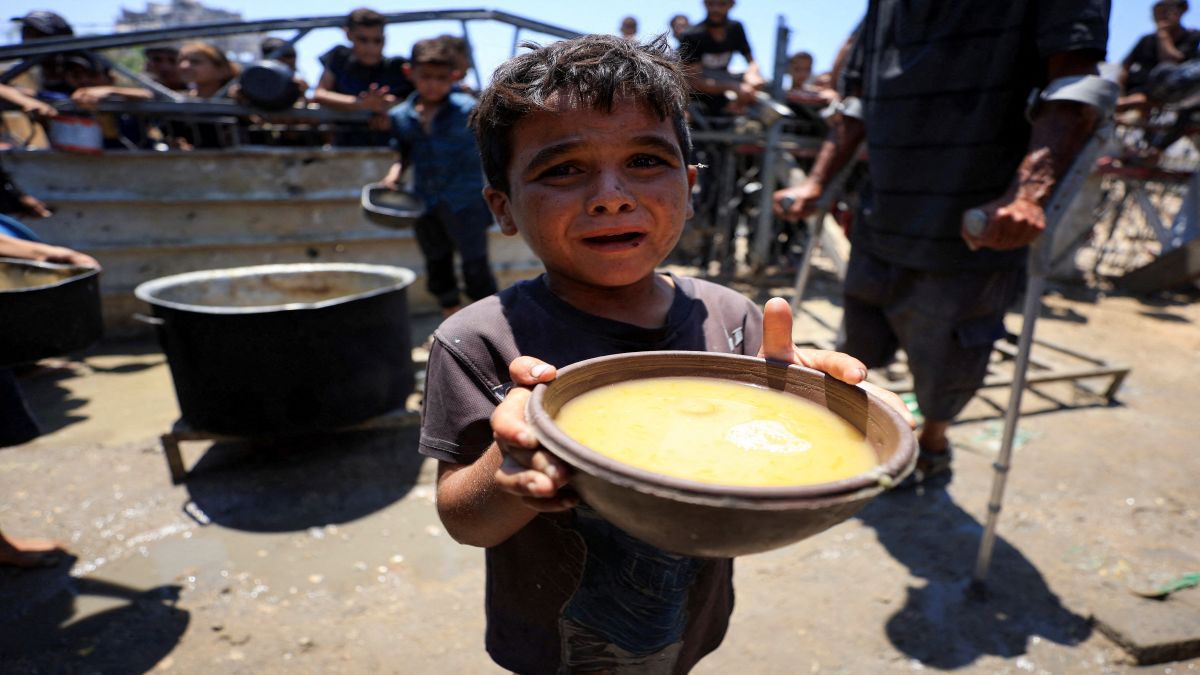A little infant’s body rests on the table at Gaza City’s Al Shifa hospital. As hospital staff remove the clothing off the infant’s body what they see is appalling — protruding ribs and hollow stomach.
But the tiny toddler isn’t a one-off case. Extreme hunger is resulting in malnutrition and deaths in the besieged enclave with the UN’s Palestinian refugee agency (UNRWA) saying that one in five children in Gaza City is malnourished and cases are increasing every day.
In a statement issued on Thursday, Unrwa Commissioner-General Philippe Lazzarini cited a colleague telling him: “People in Gaza are neither dead nor alive, they are walking corpses.”
But why is this happening? Why are all 2.1 million people in Gaza are now food insecure?
GHF: Few sites and deadly violence
Israel’s chosen aid distributor, the Gaza Humanitarian Foundation (GHF), began operations on May 26 after a more than two-month total aid blockade. Now the main channel for distributing food to Gaza, GHF has faced chaos and deadly violence at its few distribution points.
The United Nations and aid groups have refused to work with GHF, saying it was created to serve Israeli military interests. “They are not a humanitarian organisation… You don’t deliver humanitarian aid in areas that have been completely flattened and militarised,” said Arwa Damon, founder of INARA, a US-based NGO offering medical and mental health support to children.
She noted the GHF’s site locations — along two military corridors in southern and central Gaza — rather than being spread out across the territory.
Today, there are only four GHF sites in Gaza — Tal al-Sultan, Saudi neighbourhood, Khan Younis and Wadi Gaza. These are open only for eight minutes at a time and in June, the average for the Saudi site was 11 minutes. This has led to many to allege that system is dangerous by design. The Unrwa chief, Philippe Lazzarini, even said “the so-called mechanism … is a death trap costing more lives than it saves.”
In fact, according to UN figures, Israeli forces have killed nearly 900 desperate and hungry Gazans near GHF sites until July 13.
Israel has rejected calls to restore the UN-led system, citing concerns that Hamas looted trucks and resold aid meant to be distributed free of charge.
Aid organisations sidelined
Another reason for the dire conditions in Gaza according to international aid groups is Israel itself. They note that vast quantities of food are stockpiled outside Gaza but await clearance from the Israeli military.
Furthermore, inside Gaza, coordination with the military is also essential, as fighting and air strikes rage on. Damon accuses Israel of preventing aid delivery by refusing to coordinate with NGOs to grant safe passage through combat zones.
“Getting that coordination approved is incredibly challenging,” she told AFP. “Not to mention Israel’s lack of willingness to provide humanitarian organisations with a safe route to be able to ensure a secure pickup.”
The UN agency for Palestinian refugees, UNRWA , said on Wednesday it had “thousands of trucks in neighbouring countries waiting to enter Gaza — banned by Israeli authorities from entering since March”.
Israel blames UN
However, the Jewish nation denies limiting the number of humanitarian trucks into Gaza. On Thursday, it even posted footage online of hundreds of trucks with aid “sitting idle inside Gaza”.
Moreover, Israel’s Foreign Minister Gideon Sa’ar told Politico that Israel had opened up more crossing points and was allowing more aid to enter Gaza under a deal struck with the European Union.
He added that the problem was that the UN was failing to distribute more than 900 truckloads of aid parked in a fenced-off area near the Kerem Shalom crossing point in the Gaza Strip. “The problem is the UN is not distributing [aid],” said Sa’ar. “There are more than 900 trucks waiting … inside Gaza Strip, and they are just not distributing them to the people in Gaza.”
UN agencies and international NGOs reject Israeli claims that they lack the capacity to distribute food. They note that aid was distributed effectively in the past, including during the last ceasefire in the Israel-Hamas war that ended in March.
‘There’s just no food’
For people in Gaza, this has resulted in a nightmare. The few doctors inside Gaza say the mounting hunger crisis is horrific is hitting women and children the hardest. As American surgeon Ambereen Sleemi told NBC News that the neonatal intensive care unit was “full of babies that are malnourished that have struggled to get formula or get feeding.”
She added that in many cases the lack of nutrition had led to other health complications, including a surge in infection rates.
Elidalis Burgos, an American critical care nurse volunteering in Gaza, further told NBC News that she had witnessed “an entire population” suffering from starvation because of the Israeli blockade. “There’s just no food,” said Burgos, who is working at Nasser Hospital in Khan Younis. “There is just nothing getting in, hasn’t been getting in for months.”
Walaa Fathi, a resident of Gaza who is eight months pregnant, wailed about the situation, saying that Gazans were “experiencing a catastrophe and a famine that no one could have imagined”.
“I hope that my baby stays in my womb and I don’t have to give birth in these difficult circumstances,” she was quoted as telling the BBC from Deir al-Balah.
With inputs from AFP and agencies


)

)
)
)
)
)
)
)
)



